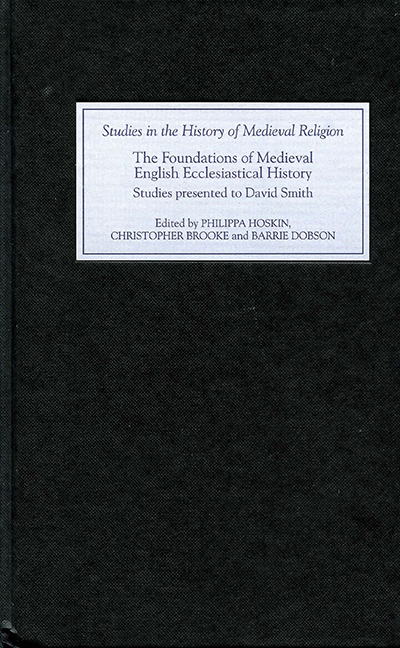Book contents
- Frontmatter
- Contents
- List of Contributors
- Acknowledgements
- Abbreviations
- Miscellaneous Frontmatter
- David Smith: the Scholar
- ‘The archivist is not and ought not to be a historian.’ David Smith and the Borthwick Institute
- Why Forge Episcopal Acta? Preliminary Observations on the Forged Charters in the English Episcopal Acta Series
- Pastors and Masters: the Beneficed Clergy of North-East Lincolnshire, 1290–1340
- The Convent and the Community: Cause Papers as a Source for Monastic History
- Patriarchy and Patrimony: Investing in the Medieval College
- ‘Above all these Charity’: the Career of Walter Suffield, Bishop of Norwich, 1244–57
- The Law of Charity and the English Ecclesiastical Courts
- Continuing Service: the Episcopal Households of Thirteenth-Century Durham
- The Acta of English Rural Deans in the later Twelfth and early Thirteenth Centuries
- The Court of Arches and the Bishop of Salisbury
- Bishops’ Registers and Political History: a Neglected Resource
- The Vatican Archives, the Papal Registers and Great Britain and Ireland: the Foundations of Historical Research
- Bibliography of the Writings of David Smith
- Index
- Tabula Gratulatoria
Continuing Service: the Episcopal Households of Thirteenth-Century Durham
Published online by Cambridge University Press: 24 October 2017
- Frontmatter
- Contents
- List of Contributors
- Acknowledgements
- Abbreviations
- Miscellaneous Frontmatter
- David Smith: the Scholar
- ‘The archivist is not and ought not to be a historian.’ David Smith and the Borthwick Institute
- Why Forge Episcopal Acta? Preliminary Observations on the Forged Charters in the English Episcopal Acta Series
- Pastors and Masters: the Beneficed Clergy of North-East Lincolnshire, 1290–1340
- The Convent and the Community: Cause Papers as a Source for Monastic History
- Patriarchy and Patrimony: Investing in the Medieval College
- ‘Above all these Charity’: the Career of Walter Suffield, Bishop of Norwich, 1244–57
- The Law of Charity and the English Ecclesiastical Courts
- Continuing Service: the Episcopal Households of Thirteenth-Century Durham
- The Acta of English Rural Deans in the later Twelfth and early Thirteenth Centuries
- The Court of Arches and the Bishop of Salisbury
- Bishops’ Registers and Political History: a Neglected Resource
- The Vatican Archives, the Papal Registers and Great Britain and Ireland: the Foundations of Historical Research
- Bibliography of the Writings of David Smith
- Index
- Tabula Gratulatoria
Summary
The medieval English bishop was a man of huge spiritual and temporal power. Throughout the thirteenth century, prelates ranked among some of the most powerful men in the land, often holding vast landed estates, as well as having spiritual jurisdiction, with the power to bind and loose which extended beyond even the authority of the king. In order to understand the ways in which any medieval baron's power was wielded, and the patterns of patronage he held, it is vital to understand the nature and construction of his household. That there were similarities between the households of great ecclesiastical and secular nobles is clear: in the household of Hubert Walter, archbishop of Canterbury, for example, in the late twelfth and early thirteenth centuries, Cheney notes that there was confusion and overlap between the ecclesiastical staff serving him as archbishop and those servants fulfilling their duties to him as baron and servant of the king, whilst the Countess of Lincoln in the early 1240s had the rules for her household drawn up by Robert Grosseteste, bishop of Lincoln, based on statutes for his own household. The studies of noble households, however, have tended to concentrate on the secular nobility, omitting their episcopal counterparts and claiming fundamental differences in their composition and continuity, claims which have been tacitly upheld in considerations of episcopal households, focusing upon the spiritual rather than temporal jurisdiction of the bishop.
The personnel and structure of a bishop's household are always elusive. The focus upon the spiritual dimension of the episcopal familia results largely from the limitations of the surviving records. Quite simply, the acts of bishops have tended to survive in ecclesiastical archives and the monks who copied them carefully into their cartularies, or preserved them in their original states, saw their bishops as guarantors of spiritualities and providers of indulgences to encourage visitors to their shrines. The secular estates with which these monks concerned themselves were their own, not their prelate's. And yet the majority of household members are identifiable through their presence in the witness lists to these episcopal charters. The strengths and weaknesses of these sources have been well rehearsed.
- Type
- Chapter
- Information
- The Foundations of Medieval English Ecclesiastical HistoryStudies Presented to David Smith, pp. 124 - 138Publisher: Boydell & BrewerPrint publication year: 2005

